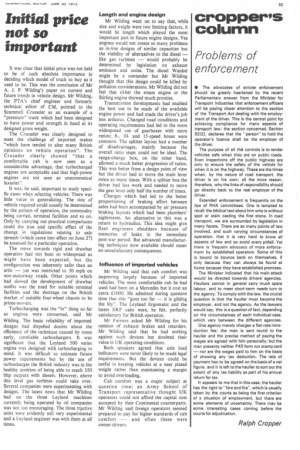Initial price not so important
Page 35

If you've noticed an error in this article please click here to report it so we can fix it.
It was clear that initial price was not held to be of such absolute importance in deciding which model of truck to buy as it used to be. This was the conclusion of Mr A. J. P. Wilding's paper on current and future trends in vehicle design. Mr Wilding, the ETA's chief engineer and formerly technical editor of CM, pointed to the Scammell Crusader as an example of a "premium" truck which had been designed to have power and strength in hand at its designed gross weight.
The Crusader was clearly designed to meet the challenge of imported makes "which have tended to alter many British opinions on vehicle operation". The Crusader clearly showed "that a comfortable cab is now seen as a considerable advantage, that turbocharged engines are acceptable and that high-power engines are not seen as uneconomical luxuries".
It was, he said, important to study specific cases when selecting vehicles. There was little value in generalizing. The size of vehicle required could usually be determined by the pattern of operation, the commodity being carried, terminal facilities and so on. Only by carrying out practical comparisons could the true and specific effect of the change in regulations relating to axle spreads (which came into effect on June 27) be assessed for a particular operation.
The move towards rigid and drawbar operation had not been so widespread as might have been expected, but the configuration was inherently safer than an artic — yet was restricted to 30 mph on non-motorway roads. Other points which had slowed the development of drawbar outfits was the need for suitable terminal facilities and the shortage on the British market of suitable four-wheel chassis to be prime-movers.
Turbocharging was the "in" thing so far as engines were concerned, said Mr
Wilding. The basic reliability of imported designs had dispelled doubts about the efficiency of the technique caused by some early, unreliable turbochargers. It was significant that the Leyland 500 series engine was designed with turbocharging in mind. It was difficult to estimate future power requirements but by the use of turbocharges the British industry was in the healthy position of being able to reach 350 bhp outputs with diesels. However, above this level gas turbines could take over. Several companies were experimenting with designs. The latest news that Mr Wilding had on the three Leyland machines currently being operated by oil companies was not too encouraging. The three tractive units were evidently still very experimental and a Leyland engineer was with them at all times.
Length and engine design Mr Wilding went on to say that, while size and weight were two limiting factors, it would be length which played the most important part in future engine designs. Vee engines would not create so many problems as in-line designs of similar capacities but the viability of alternatives to the diesel — like gas turbines — would probably be determined by legislation on exhaust emission and noise. The diesel Wankel might be a contender but Mr Wilding thought that this design could be killed by pollution considerations. Mr Wilding did not feel that either the steam engine or the Stirling engine showed much promise.
Transmission developments had enabled the best use to be made of the available engine power and had made the driver's job less arduous. Changed road conditions and operating requirements had led to the more widespread use of gearboxes with more ratios; 8-, 10and 15-speed boxes were common. The splitter layout had a number of disadvantages, mainly because the overall ratio steps could not be ideal. The range-change box, on the other hand, allowed a much better progression of ratios. This was better from a design point of view but the driver had to move the main lever twice as many times. With a splitter box the driver had less work and needed to move the gear lever only half the number of times.
Changes which had led to the better proportioning of braking effort between axles had been accompanied by air pressure braking layouts which had been plumbers' nightmares. An alternative to this was a return to hydraulics. This idea might give fleet engineers shudders because of memories of leaks in the immediate post-war period. But advanced manufacturing techniques now available should mean no unsatisfactory consequences.
Influence of imported vehicles
Mr Wilding said that cab comfort was improving largely because of imported vehicles. The most comfortable cab he had used had been on a Mercedes but it cost an extra £1000. He admitted during question time that this "goes too far — it is gilding the lily". The Leyland Ergomatic and the latest ERF cabs were, he felt, perfectly satisfactory for British operation.
Mr Furness asked Mr Wilding for his opinion of exhaust brakes and retarders. Mr Wilding said that he had nothing against such devices but doubted their value in UK operating conditions.
Both speakers agreed that axle load indicators were never likely to be made legal requirements. But the devices could be useful in keeping vehicles at a near plated weight rather than maintaining a margin to avoid overloading.
Cab comfort was a major subject at question time; an Army School of Transport representative thought UK operators could not afford the capital cost accepted by their Continental counterparts. Mr Wilding said foreign operators seemed prepared to pay for higher standards of cab comfort --and often these were owner-drivers.




























































































